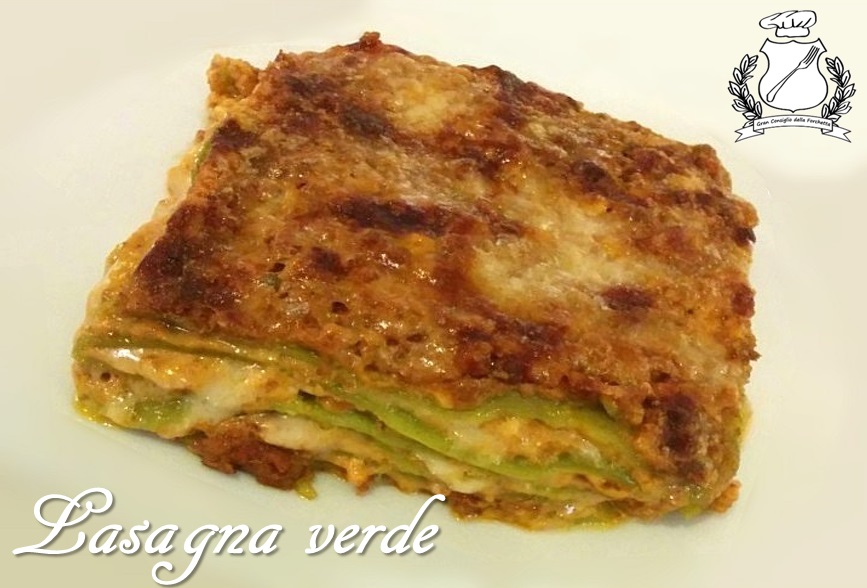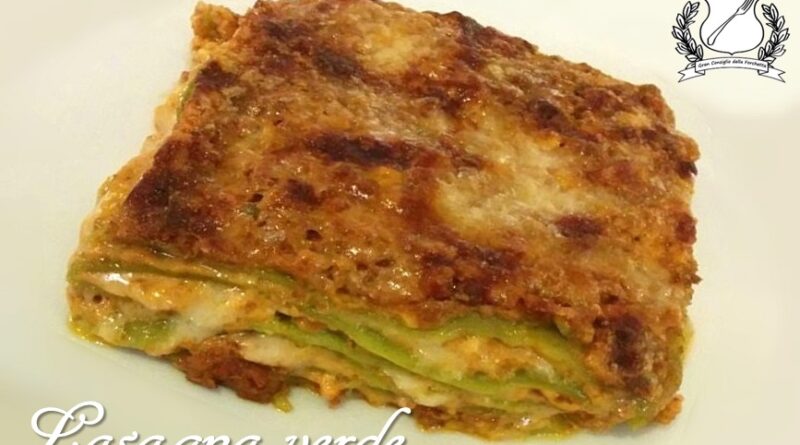Green Lasagna Bolognese

Green Lasagna Bolognese
Duration: 5 hours + 1 hour of rest
Difficulty: challenging
Region: Emilia Romagna
Green lasagna bolognese is a dish known to all and very famous, not only throughout Emilia, but also throughout the world. Strange to say, the most ancient origins of this dish can be traced back to the Neapolitan tradition (1200-1300) even if the version known to all of us is practically the Bolognese one. Layers of fresh green egg pasta, thanks to the addition of spinach in the dough, are seasoned with the famous Bolognese sauce, and enriched with béchamel sauce and grated Parmigiano Reggiano. The preparation of this dish is more than difficult and long and laborious, however the results will greatly reward the effort in preparing it!
Pairing Wine: Colli Bolognesi Rosso DOC
Ingredients
For 4 people:
To prepare the green pastry:
- 250 g of flour
- 2 eggs
- 400 g of fresh spinach
- salt
For the preparation of the ragu:
- 200 g of minced beef
- 100 g of minced bacon and ham
- 1 onion
- 1 stalk of Celery
- 1 carrot
- 1 glass of wine
- 200 ml of tomato puree
- 1 tablespoon of tomato paste
- Extra virgin olive oil
- salt
For the preparation of the béchamel:
- 500ml of Milk
- 2 tablespoons of flour
- 2 tablespoons of grated Parmesan
- Nutmeg
- Butter
- salt
Preparazione
First you need to prepare the Bolognese sauce, which can also be prepared the day before (it doesn’t matter).
Take the onion, carrot and celery and after peeling, washing and cleaning them, chop them using a vegetable knife or a crescent. Take a saucepan and after adding a good drizzle of extra virgin olive oil, pour in the chopped vegetables. Fry them for about 5-6 minutes, just long enough for all the smells to brown and then add the ground ham and bacon first and brown them well, then the ground beef. Stir during cooking with a wooden spoon in order to break up the minced meat as much as possible and thus not forming lumps of meat.
When the meat is well browned, add a good glass of red (or white) wine and continue cooking to let it evaporate. When all the wine has evaporated, add the tomato concentrate, the puree and then a cup of water. Let it cook for about ten minutes, stirring well. Season with salt and finally cover. Put the pot over a low heat and simmer the ragù for at least 4 hours (the more it bubbles, the better the ragù will be). Take care that the sauce does not dry out, taking the lid off from time to time to check and adding a little water if necessary.
Then we move on to the preparation of the fresh green pasta sheet. You can prepare this yourself, or buy it ready-made.
Take a pot, fill it with water and bring to a boil. Then once it reaches the boil, pour in the fresh spinach, after having cleaned and washed them carefully (removed the earth and any roots). Boil them not too much, so as not to lose too many substances and flavour, then drain and squeeze them well (they must not contain water). The dry spinach will be finely chopped with a vegetable knife until a pulp is obtained.
Prepare a pastry board, pouring the flour and forming the classic fountain. In the hollow in the center, pour the spinach, the eggs and a pinch of salt. Begin to knead in order to incorporate the eggs well and then until you obtain an almost homogeneous mixture. When the dough has reached the right consistency and elasticity, form a ball, cover it with transparent film and let it rest for about 30 minutes.
Once the time has elapsed, remove the transparent film from the dough and then place it on the floured pastry board. Roll out a sheet, using a rolling pin or even a machine to roll out fresh pasta. Roll out a thin green pastry less than 1 mm thick.
Let the dough dry for at least a couple of hours, being careful to use semolina flour to prevent the layers of dough from sticking together.
At this time you can start preparing the béchamel.
Take a saucepan and add the butter cut into small pieces. Put the saucepan to heat over low heat in order to slowly melt the butter. When this has completely melted, start adding the flour gradually and stirring with a wooden spoon to dissolve the flour in the melted butter. You will slowly see the dough become more and more dense. Then add the milk, also gradually, so that it heats up and at the same time continuing to mix (always in the same direction). The béchamel gradually, from dense will become more liquid, but always maintaining a creamy consistency. Be careful not to overheat, the béchamel sauce should never boil. Continue to heat, adding both the salt, a grating of nutmeg and one or two tablespoons of Parmigiano Reggiano. When it has reached the right consistency, turn it off and let it cool.
Finally, now that we have all the necessary ingredients, we can finally start preparing the real lasagna.
Take a pot and fill it with water. Bring to the boil, add a pinch of coarse salt and then boil the rectangles of fresh green pasta that you have prepared (at least 10-12 cm on each side). The boiling must be very short (if you have prepared fresh pasta) otherwise if packaged or dried, it requires gradually longer times.
Take a pan and grease the bottom with butter. Then start arranging the layers of green pasta, alternating with a little Bolognese sauce and béchamel. Layer by layer you’ll work your way up to the top of the pan. Cover with the last layer with a lot of ragù, so as to cover it completely and then add the béchamel sauce and a lot of grated Parmesan cheese.
The original recipe calls for knobs of butter to be added here and there during the preparation of the lasagna layers. I tasted traditional lasagna in Bologna and this is how it should be prepared. For those not used to it, it might be too heavy

